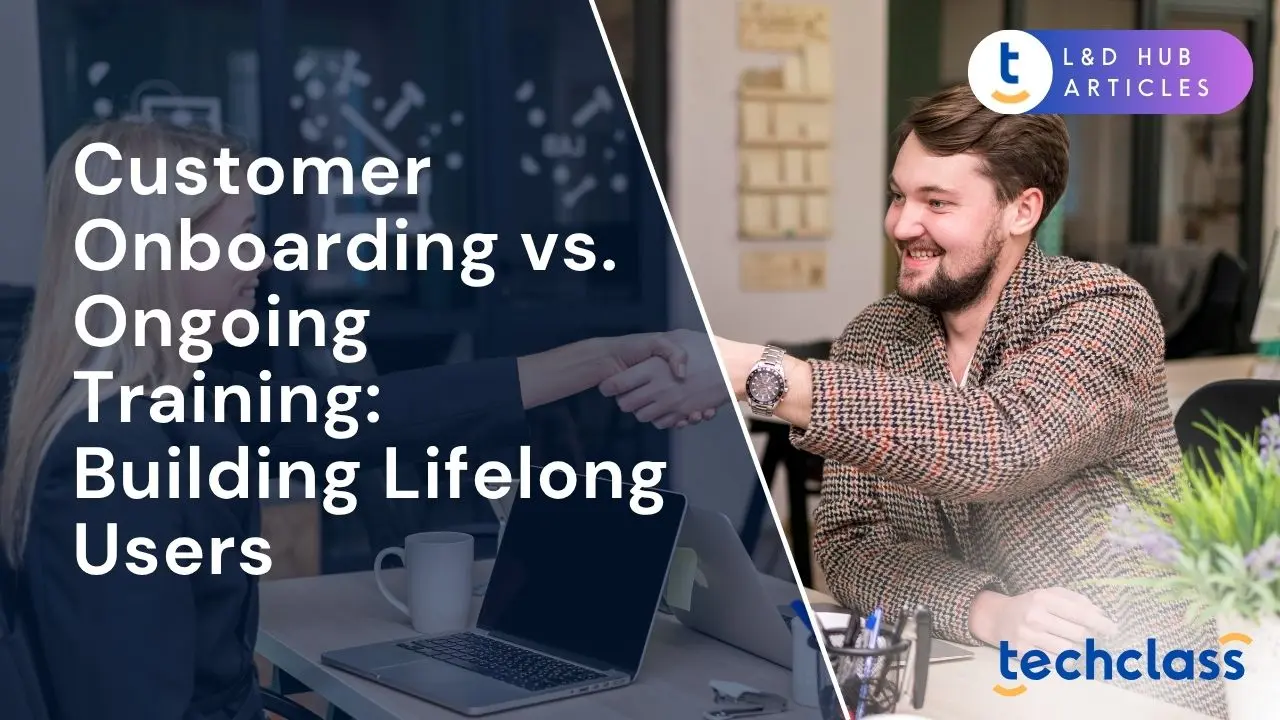
Every business leader knows that winning a customer is just the beginning. The real challenge is turning that new customer into a lifelong, loyal user of your product or service. In fact, acquiring a new customer can cost 5 to 25 times more than keeping an existing one – so it pays to invest in keeping customers happy and engaged over the long term. Two critical components of this retention strategy are customer onboarding (the initial training and orientation a customer receives) and ongoing customer training (continuous education and support throughout the customer’s lifecycle). These elements go hand in hand. A great first impression through onboarding sets the stage, and continuous training ensures customers keep getting value as their needs evolve. This article explores the differences between customer onboarding and ongoing training, why each is essential, and how together they help build loyal, lifelong users.
Customer onboarding is the process of guiding new customers through their first experiences with your product or service. This typically includes welcoming the customer, helping with setup or installation, providing initial training or tutorials, and ensuring they can achieve their first “quick wins” or goals with the product. The primary objective is to make the customer comfortable and successful in the early days of using your solution. A positive onboarding experience creates a foundation for a long-term relationship by delivering value quickly and preventing frustration or confusion.
The importance of a strong onboarding process cannot be overstated. Research shows that 63% of customers consider the quality of onboarding when deciding whether to subscribe to a new service. In other words, many prospects judge a product not just by its features, but by how well they’ll be supported in learning to use it. If the initial experience is confusing or difficult, new users may abandon the product before ever realizing its value. In fact, poor onboarding is cited as one of the top reasons for customer churn (attrition), and more than half of all customer churn can be linked to subpar onboarding and support. The fallout is costly – companies collectively lose tens of billions of dollars each year due to customers leaving over poor service or onboarding issues.
A well-structured onboarding program, on the other hand, leads to higher adoption and retention rates. By helping customers see success with your product early, you reinforce that they made a wise decision. One industry expert notes that 86% of customers remain loyal if they have access to helpful, educational onboarding content right after purchase. This means that walking new users through how to use the product and providing resources (guides, tutorials, personal assistance) can dramatically improve their loyalty to your brand. Effective onboarding also reduces early churn – some companies have reduced customer churn by nearly 45% or more by implementing skilled onboarding strategies. The first 90 days are especially critical: guiding a customer to find value in that window greatly improves the chance they’ll stick around.
Key elements of successful customer onboarding often include a warm welcome message, step-by-step setup assistance, interactive product walkthroughs, and ample opportunities for customers to ask questions. For example, providing a simple checklist or “getting started” guide can ensure users don’t feel lost. It’s also beneficial to personalize the onboarding experience to the customer’s goals or role. The faster a new customer achieves their “aha moment” – the point where they clearly see the product’s value – the more likely they are to become a long-term user. In summary, customer onboarding sets the stage for success by making a strong first impression. It builds trust, demonstrates your commitment to the customer’s success, and equips users with the basics they need to start benefiting from your product immediately. But onboarding is just the beginning of the journey; what comes next is equally important.
Winning the customer’s business is the start, and onboarding gets them up and running – but what happens in the months and years that follow? Ongoing customer training (also known as continuous customer education or enablement) refers to the continuous support, education, and skill-building opportunities you provide to customers after the initial onboarding phase. The idea is that learning should not stop once a customer is “on board.” To truly maximize the value customers get (and to keep them using your product happily), you need to offer training and resources throughout their entire lifecycle. As one customer education guide puts it, onboarding is crucial, but it’s not the final stop – effective customer training is an ongoing process that extends through the entire life cycle of the customer. In practice, this means a new customer will need different training than a veteran user who has been with you for a year. Ongoing training initiatives can include things like advanced tutorials, webinars on new features, refresher courses, how-to articles, user community forums, certification programs, and regular update workshops. The goal is to continually empower users with knowledge, so they can fully leverage your product as it evolves.
Why is ongoing training so important? First, it helps customers continue to get more value over time. Even a happy customer from onboarding can become disengaged if they aren’t kept up to date on new capabilities or best practices. Continuous education ensures that as your product updates or the user’s needs change, they can learn and adapt rather than feeling left behind. It also deepens their expertise. A customer who starts as a novice user can, through ongoing training, become a power user who utilizes advanced features and discovers new use cases. This translates into higher product adoption and usage rates – in fact, companies report that well-trained customers use more of the product’s functionality and do so more effectively. When customers know how to solve more problems with your product, they integrate it deeper into their workflows, making it indispensable.
Continuous training also has a big impact on customer satisfaction and independence. Educated customers tend to require less hand-holding from support because they can answer many questions on their own. They feel more confident and in control. Studies have found that providing ongoing educational resources (like on-demand tutorials and knowledge bases) makes users more self-sufficient, leading to fewer support tickets and faster problem-solving. One industry article notes that well-trained customers “gain self-sufficiency and feel empowered, creating a more seamless user experience,” which leads to fewer frustrations and faster issue resolution. This self-service ability is a win–win: customers get answers more quickly, and your support team is freed up to handle more complex issues. Moreover, continuous engagement through training keeps customers engaged and loyal over time. When users see that your company is invested in their success (through webinars, new feature demos, etc.), they are reminded of why they chose your solution and are less likely to start looking at competitors.
The business impact of ongoing training is significant. Satisfied, educated customers are far more likely to renew their subscriptions or continue buying from you. For example, in one SaaS company’s experience, customers who participated in their ongoing training program were over 2× more likely to renew their subscriptions than those who didn’t. This kind of improvement in renewal rate directly boosts revenue and lifetime customer value. Broader research backs this up: customer education programs have been shown to increase product retention rates by an average of 22% and increase customer satisfaction by around 26%. Some companies even see expansions in account value, as trained customers are more open to upselling and cross-selling – they learn about additional features or new products through training and often want to invest more. A study by Forrester found that training programs led to a 34.6% higher lifetime value per customer trained, highlighting how education drives not just retention but also greater spending over time. In short, ongoing training keeps users engaged, knowledgeable, and continuously deriving value, which increases their loyalty and the overall return they deliver to your business.
It’s worth noting that many leading companies treat ongoing customer education as a core part of their product strategy. They might offer customer academies or e-learning portals where users can take courses, watch video tutorials, and even earn certifications. For instance, software firms like Salesforce and HubSpot created extensive online learning hubs (Trailhead and HubSpot Academy, respectively) to regularly train and upskill their user base. These programs not only help customers use the products better but also foster a community of expert users and brand advocates. A notable example is Hootsuite’s customer training initiative: Hootsuite launched an online academy with courses and certifications to help users master social media management on their platform. The result was improved customer retention and even a new revenue stream from paid training content. This real-world case illustrates how continuous training can transform customers into power users and enthusiastic promoters of your product.
While customer onboarding and ongoing training are closely related in the customer success journey, they serve different purposes and occur at different stages. Here are some key differences between the two:
Despite these differences, it’s important to note that onboarding and ongoing training are complementary rather than opposites. They form a continuum of customer education. The line between them can sometimes blur – for example, a “30 days in” check-up training webinar could be seen as the tail-end of onboarding or the start of ongoing training. The exact definitions are less crucial than ensuring that from day one through day 1001, your customer is continually supported and learning.
When combined into a seamless strategy, customer onboarding and ongoing training create a powerful engine for customer success. Together, they ensure customers not only start off on the right foot but continue to grow and find value, ultimately turning them into loyal advocates for your business. Think of onboarding as planting the seed and ongoing training as continuously watering and nurturing that plant to maturity. Both stages feed into each other: a great onboarding experience makes a customer receptive to further learning, and ongoing training reinforces and builds on what they learned during onboarding.
Adopting a mindset that “onboarding never really ends – it evolves” can be extremely beneficial. Some customer success professionals use the term “everboarding” to capture this idea of continuous onboarding. In practice, this means regularly updating your training content and reach-outs as the customer progresses. For instance, after the initial setup, you might schedule check-in calls or send resources at the 30, 60, and 90-day marks to ensure the customer is achieving their goals. As the customer becomes more advanced, you introduce them to new features or more sophisticated use-cases via workshops or advanced courses. This kind of phased, continuous engagement shows the customer that your company is committed to their success for the long haul – not just at the start. It also allows you to address issues or knowledge gaps proactively. If a customer has stalled in using a certain feature, ongoing training (or a friendly nudge from their success manager) can re-engage them before they consider abandoning the product.
The synergy between onboarding and ongoing training directly contributes to building loyalty and lifetime value. Customers who feel supported at every step are far more likely to stay. Regular educational touchpoints keep your product top-of-mind and integrated into the customer’s processes. They also create opportunities for dialogue – customers might provide feedback during training sessions or ask questions that give insight into their evolving needs. You can then tailor future training or even product improvements to better serve them, creating a positive feedback loop. Continuous education often turns customers into experts and evangelists. When a user masters your product (thanks to your training) and sees significant benefits, they are inclined to champion your solution within their network or company. In this way, strong onboarding combined with continuous training doesn’t just prevent churn; it actively transforms customers into promoters of your brand.
From a business perspective, combining onboarding and ongoing training drives key outcomes like higher retention, greater customer lifetime value, and lower support costs. Immediately after onboarding, customers should be regularly using the product – but to keep them using it months and years later, ongoing engagement is key. Companies that excel at both onboarding and continuous training tend to report significantly lower churn rates and higher revenue from renewals and upsells. One reason is that educated customers are simply more satisfied and successful. They derive more value from the product over time, so they feel they are getting their money’s worth (reducing the temptation to switch to a competitor). Additionally, continuous training can lighten the load on support and success teams. When customers have access to tutorials, forums, and training, they can often troubleshoot or learn on their own. This means “better support means fewer help tickets and happier customers,” as one report put it. Your team then spends less time re-teaching basics or answering the same questions, and more time on high-value consulting or relationship-building. The outcome is a more scalable and efficient customer success operation.
In essence, lifelong users are cultivated through continuous value delivery and engagement. Onboarding gives that first jolt of value and reassurance, and ongoing training keeps the value flowing steadily. If either piece is missing, customers may plateau or lose interest. For example, without good onboarding, a customer might never fully adopt the product and leave early. Without ongoing training, even a well-onboarded customer might eventually feel the product no longer meets their needs or that they’re not advancing – and could drift away. But when you have both, the customer’s experience is one of being cared for at every stage: they never feel abandoned after the sale. The result is higher trust and a willingness to continue the partnership. Over time, this is how you achieve that coveted status of having “lifelong users” – clients who not only stick with you, but also enthusiastically recommend you to others. In fact, engaged customers who see continuous value are much more likely to become brand advocates. Satisfied users often “shout from the rooftops” about a product that consistently meets their needs, providing priceless word-of-mouth marketing. This kind of advocacy is only possible when the customer’s experience post-sale is as strong as all the promises made before the sale.
To implement a successful combined approach, companies should ensure a smooth handoff from onboarding into ongoing education. For instance, after a customer completes the basic onboarding steps, you might enroll them in a customer newsletter or learning portal for tips and advanced tutorials. You could invite them to virtual user group meetings or send them information about new feature training sessions. The key is to treat customer education as an ongoing journey that adapts to the customer’s level and goals. By aligning your teams (e.g. Customer Success, Support, Training departments) around this journey, you create a cohesive experience. Many businesses now leverage Learning Management Systems (LMS) or customer training platforms to manage this continuum – starting from onboarding courses and then offering continuous learning paths. The investment is worthwhile: organizations that prioritize customer enablement see tangible returns in retention and revenue. In summary, onboarding and ongoing training are both essential. Their approaches differ, but together they ensure customers are continuously gaining value, which is the cornerstone of loyalty.
Building lifelong users doesn’t happen by accident – it’s the result of a deliberate strategy that begins with excellent onboarding and continues with consistent, ongoing training. As we’ve discussed, customer onboarding gives your new users the tools and confidence to start their journey right, while ongoing training keeps that journey moving forward, adapting to new challenges and opportunities. For HR professionals, business owners, and enterprise leaders alike, the takeaway is clear: invest in your customer’s education from day one and never stop. By doing so, you create a supportive partnership with your customers. They feel valued and empowered, and in return, they reward you with loyalty and long-term business.
In today’s competitive landscape, products and services that come with strong support and learning resources have a distinct advantage. Customers are more likely to stick with a solution that they fully understand and can maximize, and they’re more likely to recommend it to others. Onboarding and ongoing training are the twin pillars of providing that understanding and maximization. The companies that master both are not just selling a product – they’re selling an evolving experience of success. That experience is what turns first-time buyers into lifetime users. Remember, the journey doesn’t end at “go-live” or after a week of usage; it’s an ongoing voyage. By guiding your customers through every step – from novice to expert – you cultivate not just users, but champions for your brand. In the end, the organizations that build lifelong users are those that see customer success as a continuous process of learning and growth. Start with a strong onboarding foundation, follow through with unwavering ongoing training and support, and you’ll be well on your way to nurturing customers who stay with you for the long haul and drive your business forward through their loyalty and advocacy.
The main purpose of customer onboarding is to guide new customers through their first experiences with your product or service, helping them achieve quick wins and become comfortable using it, which sets the foundation for long-term loyalty.
Ongoing customer training is a continuous process that happens throughout the customer lifecycle, focusing on advanced features, new updates, and skill-building, whereas onboarding occurs at the beginning to ensure initial adoption.
Blending onboarding with ongoing training creates a seamless customer experience that nurtures long-term engagement, increases retention, and turns users into loyal advocates by continually delivering value.
Onboarding success is measured through activation rates and time-to-value, while ongoing training success is gauged by product usage depth, renewal rates, certification achievement, and long-term customer satisfaction.
Yes, well-trained and educated customers are more self-sufficient, which decreases support tickets, speeds up issue resolution, and allows support teams to focus on more complex problems.
Companies can implement phased training programs, regular check-ins, on-demand resources, webinars, and community events to keep customers engaged, supported, and continuously learning.


